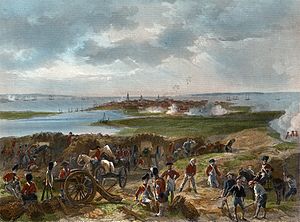
Back Setge de Charleston Catalan Belejringen af Charleston Danish Asedio de Charleston Spanish Siège de Charleston French Assedio di Charleston Italian Beleiringen av Charleston NB Cerco de Charleston Portuguese Осада Чарлстона Russian 查爾斯頓圍城戰 Chinese
| Siege of Charleston | |||||||
|---|---|---|---|---|---|---|---|
| Part of the American Revolutionary War | |||||||
 An illustration of the siege by Alonzo Chappel | |||||||
| |||||||
| Belligerents | |||||||
|
|
| ||||||
| Commanders and leaders | |||||||
|
|
| ||||||
| Strength | |||||||
|
12,847 regulars and militia 4,500 sailors 6 ships of the line 8 frigates 4 armed galleys 90 transports [2] |
6,577 regulars, sailors and militia 3 frigates 5 sloops 1 schooner 1 brig 3 armed galleys[2] | ||||||
| Casualties and losses | |||||||
|
89 killed 138 wounded 5,466 captured[5][6][a] All ships captured | |||||||
The Siege of Charleston was a major engagement and major British victory in the American Revolutionary War, fought in the environs of Charles Town (today Charleston), the capital of South Carolina, between March 29 and May 12, 1780. The British, following the collapse of their northern strategy in late 1777 and their withdrawal from Philadelphia in 1778, shifted their focus to the North American Southern Colonies. After approximately six weeks of siege, Major General Benjamin Lincoln, commanding the Charleston garrison, surrendered his forces to the British. It was one of the worst American defeats of the war.
- ^ "Battle of Charleston ***". Landofthebrave.info. Retrieved 29 May 2018.[unreliable source?]
- ^ a b "The American Revolution in South Carolina – The Siege of Charlestown". Carolana.com. Retrieved 29 May 2018.
- ^ a b Cite error: The named reference
Johnwas invoked but never defined (see the help page). - ^ Clodfelter, Micheal (2017). Warfare and Armed Conflicts: A Statistical Encyclopedia of Casualty and Other Figures, 1492–2015, 4th Ed. Jefferson, North Carolina: Mcfarland & Company. p. 129. ISBN 978-0786474707.
- ^ Greene, Francis Vinton (1911). The Revolutionary War and the Military Policy of the United States. New York Public Library. p. 210. ISBN 978-0722280089.
{{cite book}}: CS1 maint: location missing publisher (link) - ^ Morrill, Dan L (1993). Southern Campaigns of the American Revolution. Nautical & Aviation Publishing Company. p. 73. ISBN 978-1877853210.
Cite error: There are <ref group=lower-alpha> tags or {{efn}} templates on this page, but the references will not show without a {{reflist|group=lower-alpha}} template or {{notelist}} template (see the help page).
© MMXXIII Rich X Search. We shall prevail. All rights reserved. Rich X Search